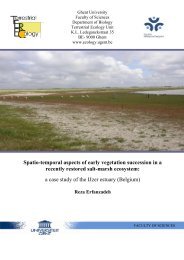PhD Arthur Decae 2010 - Ghent Ecology - Universiteit Gent
PhD Arthur Decae 2010 - Ghent Ecology - Universiteit Gent
PhD Arthur Decae 2010 - Ghent Ecology - Universiteit Gent
Create successful ePaper yourself
Turn your PDF publications into a flip-book with our unique Google optimized e-Paper software.
Nemesia santeulalia sp. n. (Figs. 54-60, 73, 86)<br />
Types: Holotype ♀ (AR14194), 8 May 1986, Ibiza, Santa Eulalia del Rio, 38.987°N, 1.530°E,<br />
burrow in clay-bank along road between pine forest and village edge. Paratypes: Ibiza: 4 ♀♀<br />
(AR14195; AR14196; 9972.4022; 9972.4023), 9-10 May 1986, Figueritas, 38.911°N,<br />
1.416°E, horizontal and slightly sloping ground in wasteland on building site; 1 ♀<br />
(9972.4021), 4 May 1986, San Antonio, 38.977°N, 1.316°E, in sandy slope on village edge.<br />
All specimen leg. A. E. <strong>Decae</strong>.<br />
Etymology: The specific name is a noun in apposition taken from the village Santa Eulalia<br />
del Rio, the type locality, on Ibiza.<br />
Diagnosis: Differs from all other known Nemesia species, except N. santeugenia sp. n., in the<br />
morphology of the spermathecae (Fig. 60). For observed differences in the morphology,<br />
burrow structure and behavior between N. santeulalia and N. santeugenia, see diagnosis of<br />
the latter species. The male is unknown.<br />
Description: Female (holotype): BL = 22.7, CL = 7.7, CW = 5.7. Leg IV: T4>F4>M4. PSP: p<br />
= 3-3; I = 2-2; II = 2-1; III = 2-; IV = 0-0. Dorsal aspect (Fig. 55). Carapace longer than<br />
wide, CL/CW = 1.4, central dark brown zones with irregular fine black line patterns radiating<br />
from fovea over yellowish brown background, posterior and lateral edges marked with narrow<br />
purplish black line, darker zones covered with black and silvery white pubescence. Caput<br />
strongly elevated, Ch/Th = 1.9, fine setae on caput crest, ocular tubercle and posterior end of<br />
thorax. Clypeus wide, Clyp = 0.27. Eye-group (Fig. 57) rectangular, AR/PR=0.99, slightly<br />
more than twice as wide as long, AR/El = 2.03, ALE as large as PLE, ALE/PLE = 1.00,<br />
posterior eyes pearly, anterior eyes greyish. POP dense and unbroken. Fovea smoothly<br />
recurved, centrally narrow; laterally distinctly widened. Chelicerae dark brown, contrasting<br />
with carapace, darker brown in areas with setae or hair cover, lighter in glabrous areas,<br />
narrow band of silvery white pubescence laterally, cheliceral furrow with six promarginal<br />
teeth, distal five equally strong, most proximal tooth smaller and placed somewhat apart.<br />
Fangs strong, blunt with smooth keel (Fig. 6). Legs yellowish brown, similar color to<br />
sternum, with darker longitudinal zone dorsally on femora and dark pigmented maculae<br />
distally on all outer surfaces of femora. Spines on metatarsi, tibiae and femora thin. Scopulae<br />
on tarsi and metatarsi I and II extending over full length of tibiae onto patellae. Prolateral<br />
spines on tibia and patella III (Fig. 58). Palp: color as legs, but without lateral maculae on<br />
femora, tarsal scopula extending halfway along tibia, three prolateral spines on patella (2 in<br />
line and 1 more ventrally). Ventral aspect (Fig. 54). Maxillae dark brown, with creamy white<br />
anterior scopula zone, longer than wide (l/w = 1.7), well developed row of cuspules along<br />
proximal margin. Sternum warm yellowish brown, darker around edges, evenly covered with<br />
setae, three pairs of well-developed sigilla, posteriors oval and placed slightly away from<br />
margin. Labium almost as long as wide, dome-shaped, strongly elevated, separated from<br />
sternum by narrow dark brown furrow. Abdomen evenly covered with fine hairs, dorsally<br />
with dense irregular pattern of dark lines and patches on light background, ventrally light grey<br />
with yellow book lung covers. Spinnerets (Fig. 59): PMS lighter than PLS, PMS small with<br />
several apical spigots, PLS proximal segment longer than median and distal segments<br />
together, spigots on apical spigot field in concentric circles around four macro-spigots.<br />
Spermathecae (Fig. 60) unipartite, compact, almost as broad as long, "potato-shape", with<br />
dense cover of glandular tissue.<br />
Variation (n=6): Adult females, medium to large spiders, BL = 18-23, CL= 6.7-7.7.<br />
Carapace, CL/ CW =1.3-1.4, CL/Ca = 1.5-1.6, Ch/Th= 1.9-2.0. Eye- formation: AR/PR =<br />
0.95-0.99, AR/El = 1.97-2.06, ALE/PLE = 0.9-1.2. PSPvar: p = 2(3); I = 2(1); II = 2(0-1);<br />
III = 2(1); IV = 0. Male: unknown.










